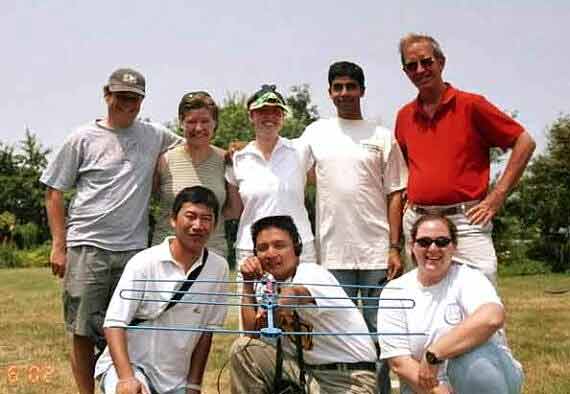

Turtle researchers (standing) Tom Mohrman, Christina Watters,
Meredith Barton, Firoz Ahmed, and Dr. Roger Wood; and (kneeling) Nara Heng,
Jichao Wang (holding radio telemetry antenna), and Joanne Woerner
 |

Radio Tracking
by Sovennara Heng
Radio tracking is used to help find out where the turtles go. There are three basic pieces of equipment: a radio transmitter with an antenna, which is glued to the turtle’s carapace, and a receiver antenna and a receiver, which are both carried by the researcher. Each transmitter sends a radio signal that is assigned a channel on the receiver.

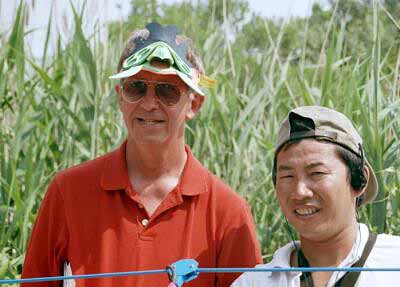

Dr. Roger Wood and Nara Heng
radio tracking terrapins in the marsh
 |

|

In the second week in June 2002, the Wetlands Institute trained the seven student researchers who are members of the turtle group to use the radio-tracking equipment. During our training, after one person hid a transmitter, each us got a chance to try one or two times to locate it. Once we find the channel that is receiving the signal from transmitter, we follow in the direction that causes the sound to increase until we are near the transmitter.
One time during a trial with Firoz, Cristina, and Meredith around Wetlands Institute, we hid the transmitter near water to simulate a situation in real turtle habitat. We got a good result, but when we put transmitter under water, the receiver did not work. So radio tracking appears to be good way to find turtles during the nesting season when they come up on land to nest, but it may not be a good way to track them under water. This may be due to the low power of our very small transmitters, and the marsh salt water may also be interfering with the radio signal.

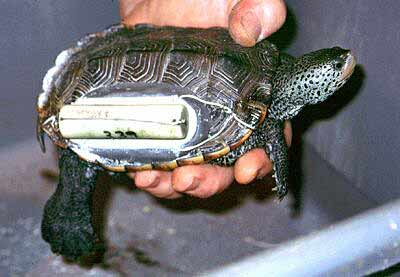

Sonic transmitter glued to a terrapin’s carapace
 |

|
 Sonic Tracking
Sonic Tracking
by Jichao Wang
Sonic tracking experiments began in 2000 to determine the range of activity of terrapins in the murky waters around the Wetlands Institute. In 2000, using terrapins that had been rescued from crab traps, student researchers tagged nine small females with sonic transmitters late in the year. In 2001, 17 females that nested along the nature trail were tagged.
By looking at the records from last year, I can see one female was killed on Stone Harbor Boulevard by a car about two weeks after a sonic transmitter had been attached to her. That transmitter was then placed on a different turtle, which was released that year.

The sonic transmitter tags make a series of ping sounds that can only be heard underwater with a hydrophone, an underwater microphone. The transmitter is sending out pings, and the hydrophone “hears” the pings and sends the signal along a cable to a receiver with speakers. I hear the pings in a series separated by pauses, which will indicate a number. For example, if I hear 3 pings, a pause, 5 pings, a pause, 7 pings, then a double pause, and then the sequence starts over again, the number of the transmitter (and the turtle) is 357. Each turtle’s transmitter has a different series of 2, 3, or 4 digits, so we can tell one turtle from another, even in the murky water.
On 26 June we found another female laying eggs along the nature trail. When she finished her nest, we took her back to the lab, injected a PIT (a Passive Integrated Transponder microchip) tag into her, and mounted a sonic transmitter on her.
We let her go in the creek off of the Institute’s dock, and right now we are following her from creek to creek. She may lay more eggs in a week or two, or maybe she is done for the season and will migrate to some distant creek, or she may even stay right around the Wetlands Institute.
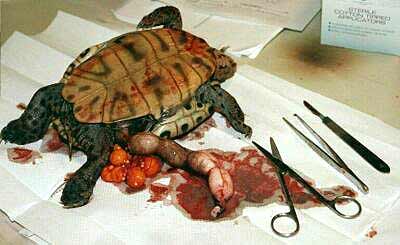

Eggs are visible in the terrapin’s oviduct.
 |
 Eggectomy
Eggectomy
by Sovannara Heng
An eggectomy is performed on a diamondback terrapin killed by accident on the road. We take the eggs from
turtle by cutting the area just in front of the hind legs. Then the oviduct is opened to get the eggs.
The road-killed female’s plastron and carapace are measured (when not too badly damaged), and she is checked for a possible PIT tag.
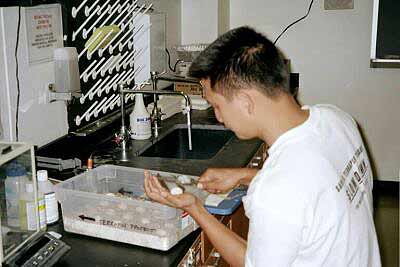

After rinsing the recovered eggs, Jichao
places them in a container for incubation.
 |
 The eggs are cleaned by rinsing and put in a container for incubation. A data sheet is used to record the location, date, time, and number of eggs, and the width, length, and weight measurements for each egg are recorded.
The eggs are cleaned by rinsing and put in a container for incubation. A data sheet is used to record the location, date, time, and number of eggs, and the width, length, and weight measurements for each egg are recorded.
As of 27 July we have found 541 dead female terrapins during our road patrols (this number is somewhat greater compared with last year’s total of 513). More than 900 eggs have been sent to Stockton College to incubate.
|